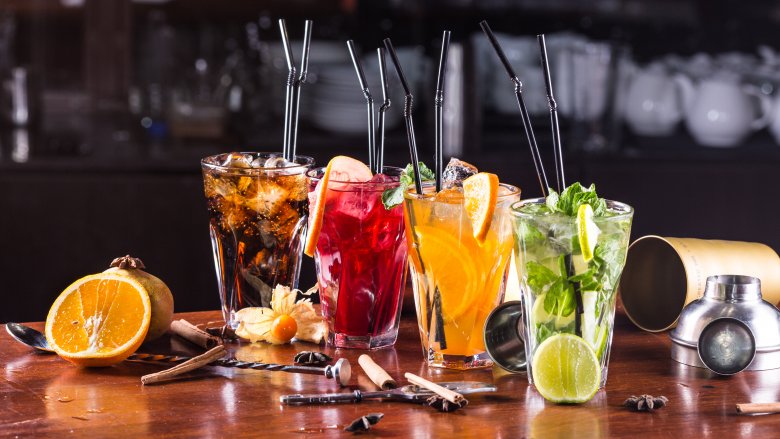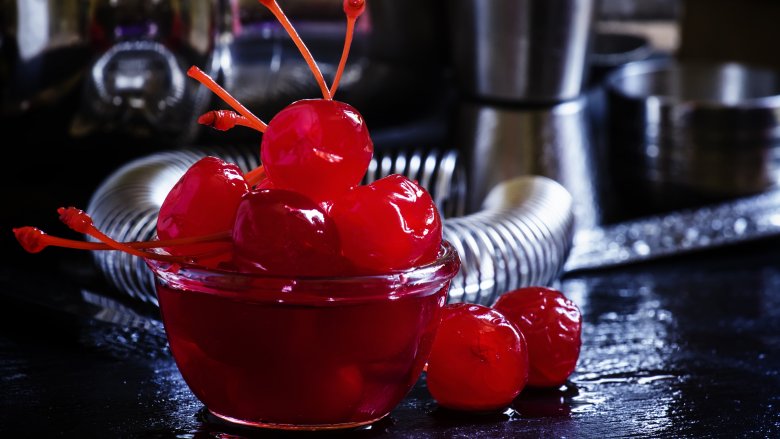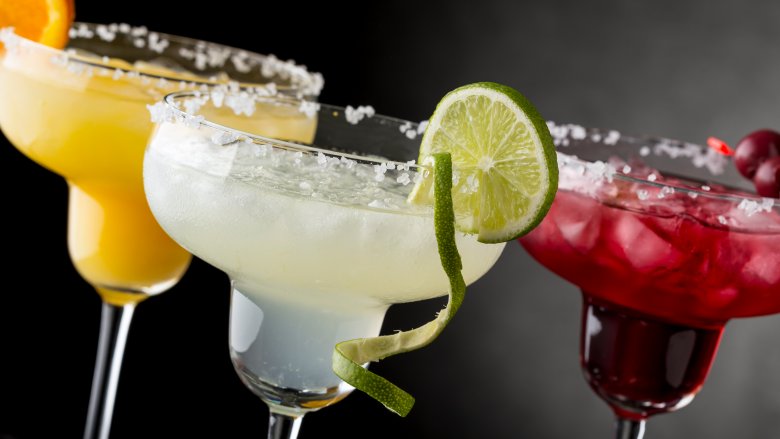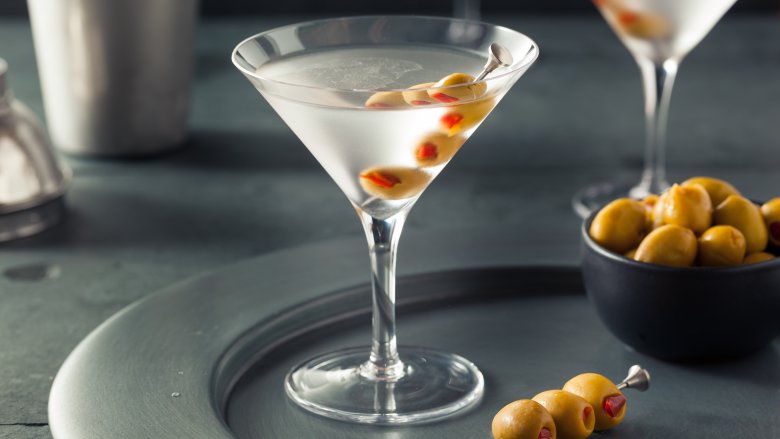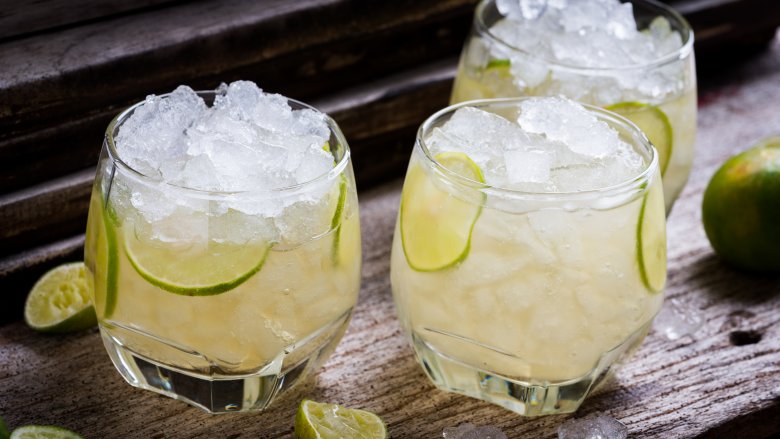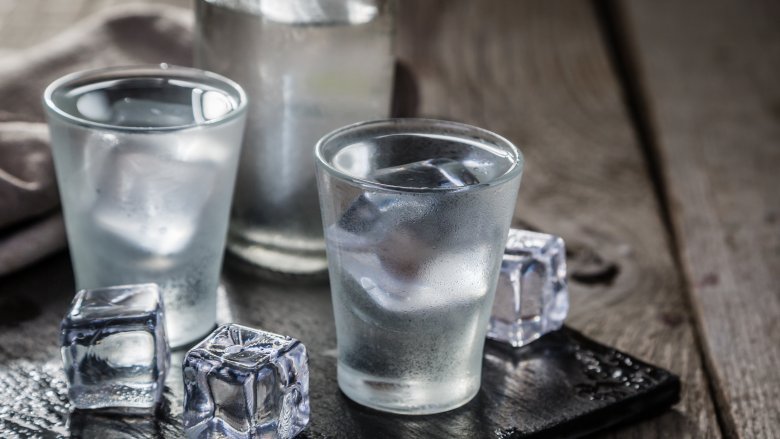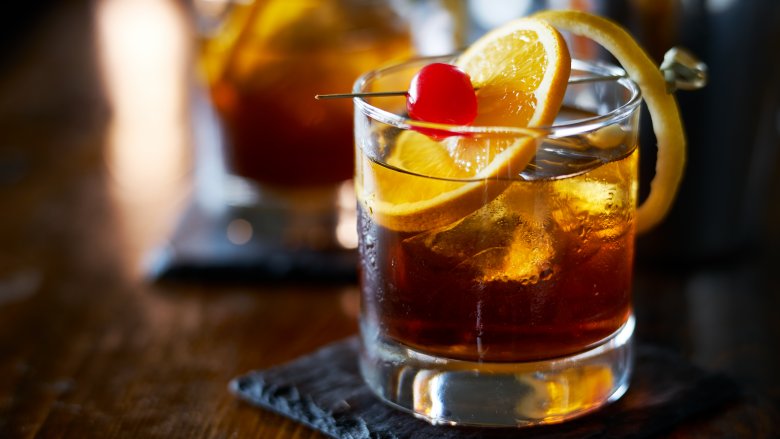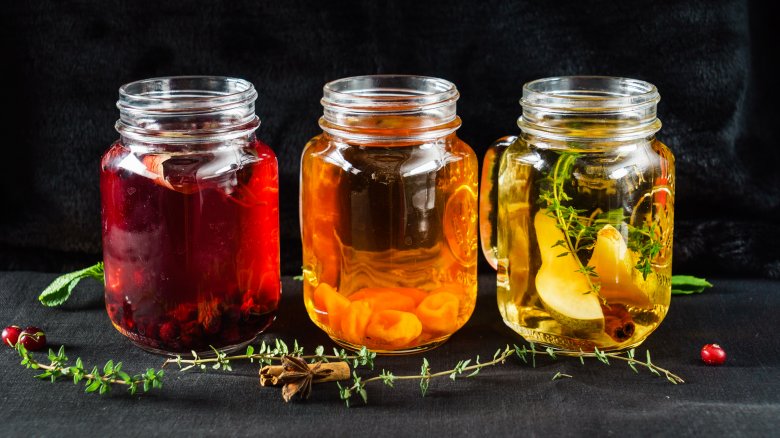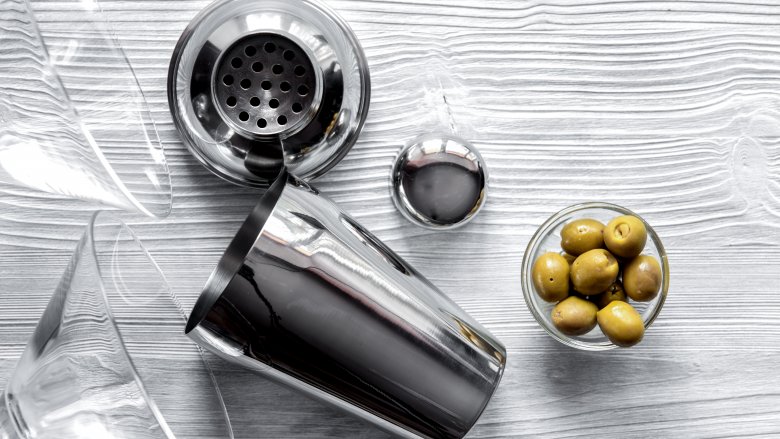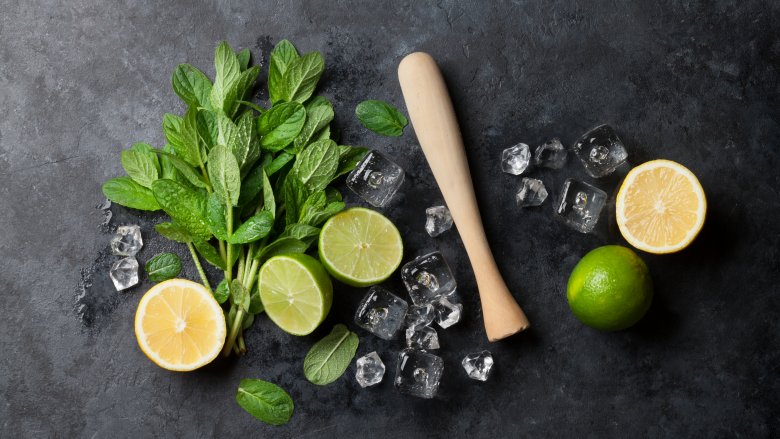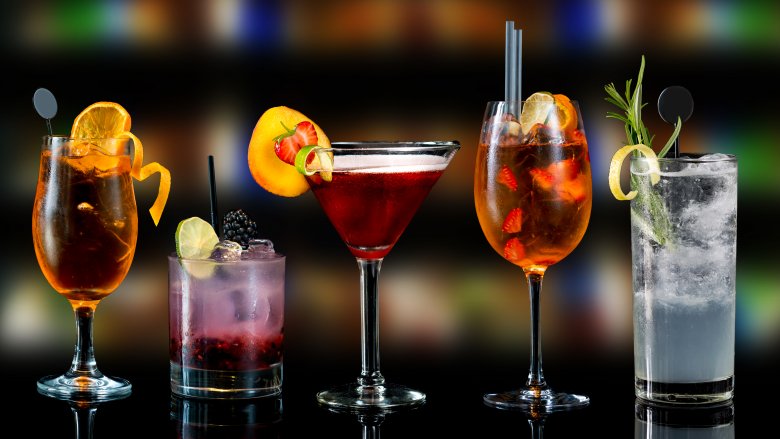Ways You're Ruining Your Cocktails
When you're out at a bar, you don't have much say over every little detail that goes into making your cocktail. Sure, you can call a brand name liquor, you can decide whether you want it "up" or "on the rocks," and you can choose the desired garnish for your martini. But you have no control over most of the ingredients, the recipe, or the technique being used to make your drink. Solution? Do your imbibing at home. But first, definitely learn how not to ruin a perfectly good cocktail.
Turns out there are plenty of mistakes to be made when it comes to at-home bar-tending, but they all have relatively easy fixes. Take that bottle of cheap vodka, for instance. Did you know you can utilize a standard kitchen gadget to make it taste a whole lot better? Read on to find out how, along with more tips and tricks to keep your adult beverages from being poured down the drain.
You're using the wrong cherries
It shouldn't come as much of a surprise, but those neon red maraschino cherries that we stuffed into our virgin drinks as kids are not the most natural ingredient you can add to a cocktail. Let's see what the FDA has to say about them, shall we? According to its website, "The term 'Maraschino Cherries' is regarded as the common or usual name of an article consisting of cherries which have been dyed red, impregnated with sugar and packed in a sugar syrup flavored with oil of bitter almonds or a similar flavor." Cringe-worthy, right?
Obviously, maraschino cherries that glow are out. No old-fashioned wants to be sullied by fake sugar syrup. But there's another kind of maraschino cherry out there — the real maraschino cherry, and you should absolutely be putting those in your cocktails. Luxardo Maraschino Cherries, said to be the original, are candied with sour Marasca cherry juice and sugar, without preservatives or coloring. They're a deep, dark purple-red color, and — since all maraschino cherries are not created equally — it's worth mentioning that they actually taste like cherries. Really, really good cherries. Your cocktails will thank you.
You're using pre-made mixers
We all know that Martha Stewart is the queen of entertaining, and therefore we should all follow her simple piece of advice on how to make a great cocktail. She says, "The juice must be fresh. No mixers, and no Skinny Girl." Amen, Martha.
When you buy a bottle of sour mix or other mixer off the shelf, you have no idea what it will taste like. Plus, chances are, most selections will be chock full of additives and preservatives. You don't want to chance ruining a cocktail with a funky tasting mixer when you can easily make them at home. Time to put on your Martha Stewart hat and pull out the juicer...
- Fresh citrus juice is a no-brainer. Squeeze lemon, lime, orange, or grapefruit for flavor that beats any bottle.
- If you can boil water, you can make simple syrup. Combine equal parts water and sugar in a saucepan and simmer until the sugar is dissolved.
- Sour mix is just simple syrup and citrus juice. Make the syrup by heating 1 cup sugar and 1 cup water until the sugar is dissolved. Once cool, combine with 1 cup fresh lime juice and 1 cup fresh lemon juice.
Though these extra steps require a bit more effort than unscrewing a cap, you'll definitely taste the difference.
You're using the wrong garnish
Sure, there are people who don't care which garnish is adorning their beverage, or even if there is a garnish present, but serious cocktail connoisseurs will notice and they will care, because using a lemon twist when it should have been an olive is simply blasphemous.
Aside from just looking pretty, a garnish is typically added to a drink for a reason. Some add sweetness, some brighten things up, some add a salty, savory flavor. Here's the skinny on garnishes:
- A twist is used when you want to introduce pungent citrus oil to a drink. Twisting lemon, lime, or orange peel over the cocktail or running it around the rim of the glass is as much for flavor as it is looks. Think old-fashioneds and martinis — they wouldn't be the same without that hit of citrus.
- Onions and olives give a savory, briny flavor to cocktails. Gibsons and gin martinis are very similar drinks, save for the difference in garnish — a Gibson comes with an onion; a martini gets an olive. Proof that garnish matters.
- Maraschino cherries add a deep sweetness and take away a bit of a cocktail's harshness in bourbon and whiskey drinks like an old-fashioned or a Manhattan. Just make sure you use the right ones!
You're using the wrong ice
Ice might seem like an inconsequential part of the cocktail-making process — its only purpose is to chill whatever's in your glass, right? — but using the wrong kind has the potential to ruin an otherwise fine drink.
There's a good reason different shapes of ice are used in different cocktails, and that has to do with how quickly the ice will melt. The size of the pieces we use in a drink that gets sucked down in minutes, like a mojito, can be smaller, but for a drink that's meant to be sipped a little more slowly, those smaller pieces will only serve to water things down before we're done. And nobody likes a watered down cocktail.
Use standard ice cubes for drinks like margaritas, punches, and Long Island iced teas. Larger cubes, or the oh-so-trendy sphere of ice, are perfect for the aforementioned old-fashioned, along with other bourbon and whiskey cocktails, or for anything served straight. Crushed ice is used for mai tais and mint juleps, but is also the best start of frozen blender drinks, like daiquiris and margaritas.
You're not filtering cheap vodka
Super-cheap vodka may have been your go-to shooter in college, but now that you're making cocktails and you actually care how they taste, it might not be as good as you remember from your kegger days. Maybe you still have a bottle in your cabinet though, or maybe you're just that frugal. Either way, there's a trick to improve the taste of that inexpensive vodka before you ruin your next batch of jungle juice... er, something way fancier than that, of course.
With the help of a regular ol' water filtration pitcher, your cheap vodka won't taste quite so cheap. By pouring it through the pitcher four times, you're replicating the filtration process of the more costly stuff. Now, as much as this method will help smooth harsh flavors out, you probably still won't want to drink it straight. But according to America's Test Kitchen, when served in mixed drinks in a blind taste test, it passed with flying colors. If only you'd known this technique in college...
You're using cheap booze when it matters
We've covered how to get away with using cheap vodka, but even then you're limited to mixed drinks and Jell-O shots where you can't taste the booze. Sometimes you really do need to break out the good stuff, because, let's face it, a gimlet made with a $7 handle of gin probably isn't going to get rave reviews.
Depending on what you're mixing up, quality really does matter. We're talking about drinks where the liquor is the star of the show — classic cocktails that tend to be no-frills and have few ingredients, where the focus is on the expertly made drink and superb ingredients. So pony up for a decent bottle of bourbon to make a great old-fashioned. Splurge on a pricey bottle of vodka for an extra-smooth martini. Invest in a few bottles of artisanal bitters. Just remember not to waste it all on one ridiculously expensive Long Island iced tea.
You're not making homemade infusions
Flavored vodkas and rums can be a fun deviation from the norm, but buying pre-made bottles off the shelf is where you go wrong. These concoctions are often reminiscent of cough syrup and only vaguely resemble whatever flavor the label is promising — not ideal for a tasty cocktail.
The good news is that making homemade infused booze is super easy, and you can play around with any flavor combination you can dream up. Things like fruits (berries, watermelon, citrus, mango, pineapple), herbs (rosemary, basil, thyme), and spices (whole cinnamon, star anise, cloves, vanilla bean) are typical in an infusion, but you can think outside of the box too. How about bacon with hot chili pepper? Or your favorite candy... Sour Patch Kids vodka, anyone? Depending on the ingredients, the time needed to infuse will vary, but typically a few days is all it takes. Taste a sample each day to determine if the flavor is right.
Here's how it's done: Start with plain vodka or light rum in a Mason jar (or other glass container with a lid). Add whatever ingredients you choose, seal it up, give it a shake, and store it in a cool spot out of sunlight. Shake the jar a few times a day until the infusion is ready. Once you've achieved the desired flavor, strain the liquid through cheesecloth and enjoy the fruits of your labor.
You're shaking when you should be stirring
James Bond famously preferred his martinis "shaken, not stirred," but that doesn't necessarily mean it's the correct way to drink them. There is a correct time to shake, and a correct time to stir, and the two methods are not interchangeable. As it turns out, Bond's preference would be doing that martini a disservice. Here's why:
Shaking a cocktail is meant to introduce air into the liquid, which creates a frothy texture and is necessary when using mixers like citrus or cream-based additions. This method does cause the ice to break down some in the process, but the dilution helps balance the flavors of the drink.
Stirring a cocktail is a gentle way to chill the liquid and combine ingredients without introducing air. This keeps things silky, dense, and clear. Generally speaking, cocktails that are made up of all liquor (not containing mixers) should be stirred, meaning drinks like martinis and Manhattans stay out of the shaker. Sorry, 007.
You're making a mess of muddling
Muddling seems like a pretty simple technique: You throw a few ingredients into a glass, mash them into oblivion with a blunt object, and continue on with your Tom Cruise Cocktail impersonation, right? Wrong. There's actually a correct way to muddle, or you run the risk of ruining a perfectly good mojito.
Believe it or not, there are several things to be considered when muddling. For starters, you want to make sure to choose a thick, sturdy glass to make your cocktail. A thin one can be too easily broken by overzealous muddling. Second, the muddler itself should be flat-bottomed and unlacquered — utensils with teeth on the end are too rough on herbs; and any lacquer eventually wears off into your drink. Lastly, and probably most importantly, know your own strength. The muddler is not meant to mash mint leaves or other herbs into a puree. In fact, when you overwork some herbs, like mint, the veins in the leaves release chlorophyll, which is bitter and will make an otherwise fine cocktail taste like freshly cut lawn.
You're using the wrong glass
It's time to ditch the red Solo cups, kids. Sure, they're an easy choice — no dishes to wash, unbreakable, great for beer pong — but they're not doing your cocktails any favors when it comes to taste.
Aside from the standard wine glasses and pint glasses, there are a few other cocktail-centric styles you might want to consider adding to your arsenal:
- Martini (or cocktail) glasses are meant for serving drinks without ice. Use these for classic martinis, of course, and cocktails that are shaken and strained, like Manhattans and cosmopolitans.
- Rocks (or lowball) glasses are meant for building drinks in, like the old-fashioned. These are the cocktails you'll likely stir, not shake, as well as liquor served straight up.
- Highball (or Collins) glasses are meant for mixed drinks with lots of ice, like a mojito or bloody Mary.
Not convinced? Do a martini taste test out of a proper glass and then a red cup, and see if you can't tell the difference.
